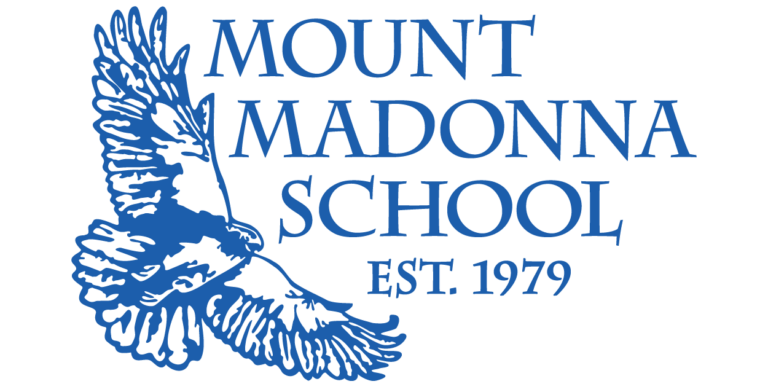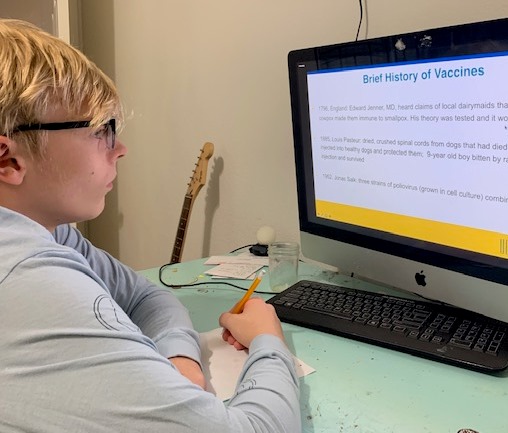 This week, Mount Madonna School (MMS) all high school honors science students attended “Viruses and Vaccines,” a lecture by Rebecca DuBois of the University of California, Santa Cruz (UCSC) via Zoom. Dubois is an assistant professor of biomolecular engineering with UCSC’s Jack Baskin School of Engineering. The lecture was part of the University’s 2020 Kraw Lecture Series on Science and Technology.
This week, Mount Madonna School (MMS) all high school honors science students attended “Viruses and Vaccines,” a lecture by Rebecca DuBois of the University of California, Santa Cruz (UCSC) via Zoom. Dubois is an assistant professor of biomolecular engineering with UCSC’s Jack Baskin School of Engineering. The lecture was part of the University’s 2020 Kraw Lecture Series on Science and Technology.
“As our ninth grade biology class shifted from in class instruction to remote learning, I have incorporated the science of COVID-19 into our curriculum,” shared teacher Nicole Silva. “MMS biology students have been reading science articles, listening to experts, watching videos and having discussions about the COVID-19 pandemic. Students are learning about immunology, virology, vaccines, and the historical and social context of pandemics.”
DuBois studies “the molecular mechanisms of human virus surface and replication proteins using a diverse toolkit of structural and biochemical techniques,” according to the university website. She uses her discoveries to design novel vaccines and antiviral therapeutics.
In her lecture, DuBois shared insight on cutting-edge research into the mechanisms and potential therapies of COVID-19. She is involved in development of assays for antibodies that provide quantitative levels of immunity and discussed that research, as well as giving attendees a solid background on the science of viruses, coronaviruses, human immunity and vaccines.
The MMS academic curriculum includes four years of high school laboratory science, including physics, chemistry, biology, AP Physics, Science with Humanity, and marine and oceanographic sciences. MMS non-honors high school science students were also given the option to attend, and at least one student participated in the opportunity.

“Professor DuBois discussed ELISA testing, which is something we cover at MMS,” commented teacher Lisa Catterall. “Our students recognized this technology; and as a teacher, I found this rewarding. Because our science classes are designed to be flexible and to emphasize inquiry and process over memorization, we have the freedom to take the time to have the students study relevant material in depth. This was a great example of that.”
Several MMS student attendees reflected on what they learned through the lecture and about some of the vital research that is currently underway:
“Professor DuBois talked about Respiratory Syncytial Virus (RSV) and how their initial vaccine failed because the virus’ antigen had a pre-infection and post-infection structure and they had injected deactivated viruses,” shared ninth grade student Zoey Ocampo-Sobkoviak. “Coronaviruses antigens also have pre- and post- infection structures. I learned about the phases that scientists go through to make a successful vaccine, and how it takes a very long time for this process to happen. I knew some of the information already, but I did learn about many more types of vaccines; and that there is a type of vaccine that works by injecting another harmless virus into the bloodstream and the already-present virus attaches to it. It was interesting to learn about different antigen shapes and how antibodies respond to them.”
“Proteins on the surface of a virus are keys to get into the cells,” noted classmate Bella Cambell. “I learned that immune system responses have two branches, one is innate immunity, which is short-term protection and nonspecific. The other is adaptive immunity which is long-term specific and germ specific. It was interesting to hear that vaccines train the adaptive immune response, they contain antigens from a specific virus, and simulate antibody production in humans.”
“In the beginning of Professor DuBois’s lecture I felt partially proud and partially bored, because I already had learned everything that she was telling us,” shared ninth grader Sam Kaplan. “However once she got into her own research about the respiratory virus, I was instantly intrigued. I was especially interested in the way that they mapped out the antigens, by crystallizing them, shooting light through them, and then recording the diffraction pattern. It made me think of the two-slit experiment in quantum physics and the incredibly creative things people do to see the unseeable.”
 “The most interesting thing I learned was that one teaspoon of ocean water contains around one million viruses, reflected classmate Cecily Kelly. “It is scary to think that every time we swim in the ocean we are exposing ourselves to millions of viruses, and we don’t even know about it! Even though these viruses are not harmful, it is still crazy. I also learned that the vaccine for rabies was created by Louis Pasteur. He created it by drying and crushing spinal cords from dogs that had been killed by rabies. He then injected this vaccine into healthy dogs, which protected them from rabies. This vaccine was used to save a young boy who had been bitten by a rabid dog. Another interesting fact I learned was that vaccines should look like the virus at the anatomical 3D level, so they can attach to the virus and act as antibodies.”
“The most interesting thing I learned was that one teaspoon of ocean water contains around one million viruses, reflected classmate Cecily Kelly. “It is scary to think that every time we swim in the ocean we are exposing ourselves to millions of viruses, and we don’t even know about it! Even though these viruses are not harmful, it is still crazy. I also learned that the vaccine for rabies was created by Louis Pasteur. He created it by drying and crushing spinal cords from dogs that had been killed by rabies. He then injected this vaccine into healthy dogs, which protected them from rabies. This vaccine was used to save a young boy who had been bitten by a rabid dog. Another interesting fact I learned was that vaccines should look like the virus at the anatomical 3D level, so they can attach to the virus and act as antibodies.”
“Overall, I think this online lecture was very informative and it gave me a better insight into how viruses work and how we can use vaccines to keep people safe,” acknowledged ninth grader Mariah Cohen. “I thought it was interesting how they started off the lecture by saying a positive from this pandemic. They said this was the most people they have ever had on one of these lectures and that is due to the shelter-in-place that has been issued due to this virus. If I’m speaking honestly, the first half or so of the slideshow presentation almost felt like a review for me over how viruses and vaccines work with the antigens and antibodies, because of all the research we’ve done in school about viruses and vaccines and COVID-19 specifically.”
“MMS biology students can go far past the media headlines and know the intricacies of microbiology and what this means for them, the general population and our world as a whole,” commented Silva. “They have studied the exponential and logistic growth of this virus’ spread and the mathematical reasons for shelter-in-place and social distancing. They have watched TED EDs, attended this webinar with Professor Dubois and a researcher currently working on COVID-19 testing, and read articles with pandemic experts on what they predict the future holds based on past history, current science and the sequential phases pandemics exhibit.”
As part of their biology class curriculum, MMS students recently studied what happens to the human body’s physiology when infected with COVID-19, the details of how vaccines protect people, and why it will take so long to develop a viable vaccine to combat COVID-19.
“Our high school biology students understand the process of double-blind studies with placebos and control groups to find effective and safe medications and treatments for people,” said Silva. “Students have also read about how this zoonotic virus mutated from what we presume to be bats to pangolins to humans, and why this happens. They’ve learned about why this has been happening and may happen with more frequency in the future due to human behavior.”
###
Contact: Leigh Ann Clifton, director of marketing & communications,
Nestled among the redwoods on 375 acres, Mount Madonna School (MMS) is a community of learners dedicated to creative, intellectual, and ethical growth. MMS supports its students in becoming caring, self-aware, discerning and articulate individuals; and believe a fulfilling life includes personal accomplishments, meaningful relationships and service to society. The CAIS and WASC accredited program emphasizes academic excellence, creative self-expression and positive character development. Located on Summit Road between Gilroy and Watsonville. Founded in 1979.




